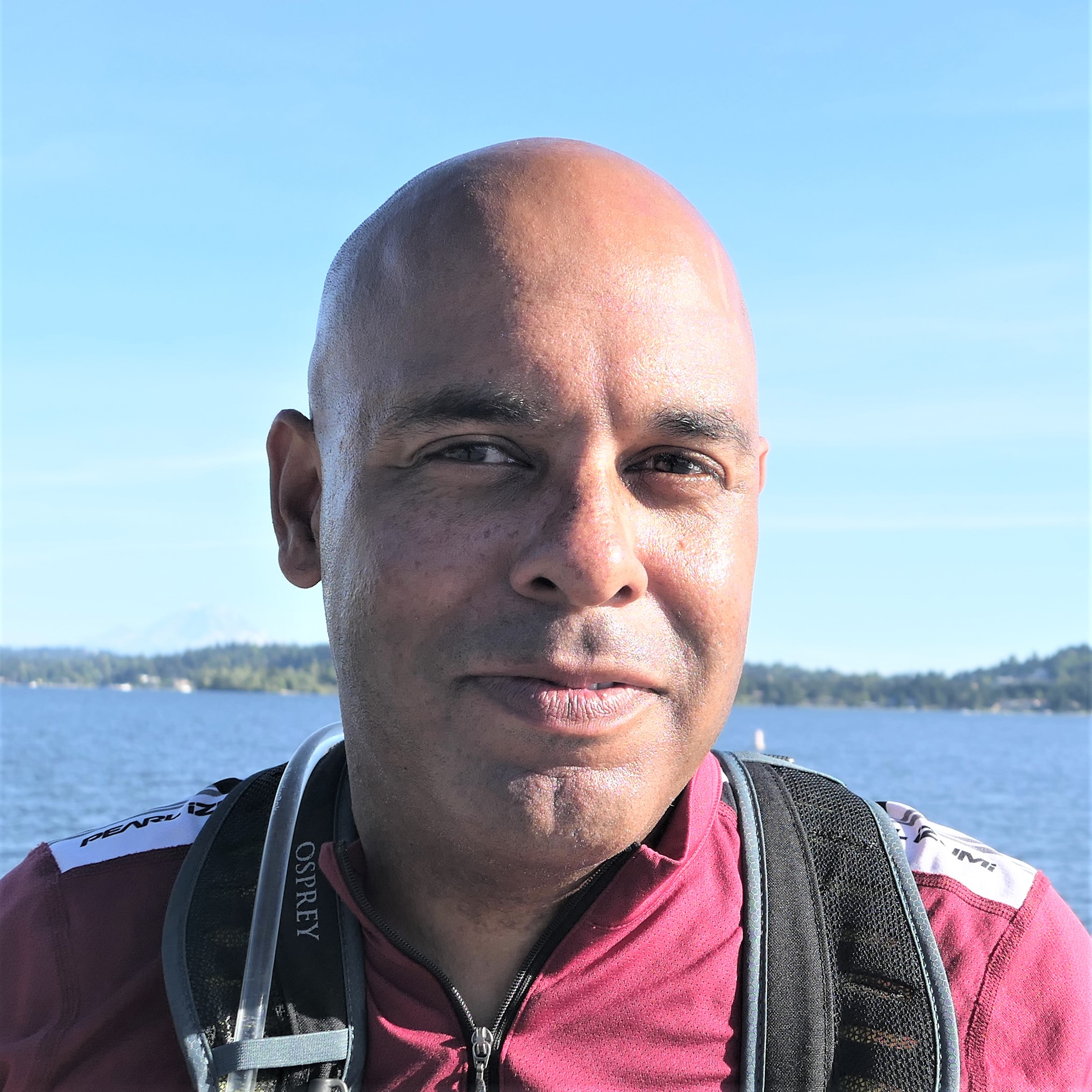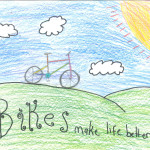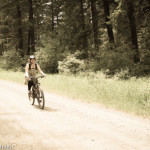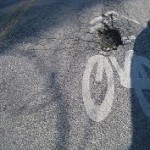- Lee Lambert officially begins on Sept. 12 at Cascade’s Brats & Brews Family BBQ fundraiser.
- We took a spin with our new ED to learn about his love of bikes, teaching his kids to ride, his views on how Cascade and Washington Bikes can boost bicycling–and make our organizations leaders in racial equity and climate action.

Lee Lambert has loved bikes since learning to ride as a child in a church parking lot. His first bike was an orange Huffy with a banana seat and rear suspension. These days, he rides a Novara road bike from REI for commuting and touring, a full-suspension mountain bike for weekend singletrack adventures, and a tandem bicycle on which he and his wife have completed STP, RSVP, and many other group rides.
“I’ve ridden bikes all my life for recreation, transportation, commuting, and exercise. Bicycling is part of who I am,” he says.
Lambert begins his job as the new executive director of Cascade Bicycle Club and Washington Bikes on Sunday, Sept. 12. Members and donors can meet Lambert that day by registering for the Brats and Brews Family BBQ and Pedaling On Fundraiser.
Lambert comes to Cascade following a long career in public service and nonprofit leadership, with stints as executive director of City Year Seattle/King County, and the Washington STEM Network, as well as staff roles with U.S. Sen. Maria Cantwell and U.S. Rep. Adam Smith, of the 9th Congressional District. Read more about his hiring and background in our press release.
Lambert, 46, joins Cascade in its 51st year at a pivotal time in the organization’s history as it grapples with the challenges–and opportunities–of the pandemic. Revenues declined due to the cancellation of many events that fund Cascade’s advocacy, education, and community initiatives. But the pandemic also spurred a bike boom as more people across Washington took up riding for health and happiness. Cascade is now ramping up its events season to meet the public desire to get out and ride, while Washington Bikes is working to advance policy initiatives that support more bicycling infrastructure across the state to meet the increased demand for safe places to ride.
Lambert will have a hand in shaping Cascade’s and Washington Bikes’ new missions, as well as both organizations’ efforts to create a more equitable, diverse, and welcoming bicycling culture that helps more people ride for a healthier and more sustainable future.
Before he takes the helm, Lambert has been on a “listening tour” during which he rides with members of the Cascade staff and board to solicit ideas. We met for a quick spin over the SR 520 Bridge Trail that connects Seattle to the East side. We chatted about his lifelong love of bikes, and how he can use his background in public policy, youth empowerment, educational attainment, and diversity initiatives, to help Cascade and Washington Bikes advance their missions. One of his goals is to make Cascade a truly statewide organization despite its historical epicenter of work in the Puget Sound region.
Lambert and his wife live in Shoreline and have two teenage children. He has ridden STP four times (twice on a tandem with his wife), RSVP once, Chilly Hilly twice, and the Kitsap Color Classic three times.
Q: What inspired you to work with Cascade and Washington Bikes?
Lambert: I love bikes and I chose a career as a nonprofit director, so this is a pairing of my professional and personal passions.
Can you share some favorite memories of riding STP and RSVP, and what compelled you to participate in these signature Cascade events?
I did STP for the first time with my Uncle Andrew who has been my bike riding companion since I was a teenager growing up in Tacoma. He lived one block away and we would go on long rides together. One of those must have been around the time of STP because we saw the route markers. That was my first awareness of it.
Two of my STPs have been on the tandem with my wife. It’s a great experience. I’ve never been a fast rider but on a tandem you can really get cruising. Another tandem couple once told us: ‘Whatever direction your relationship is going, you’ll get there twice as fast on a tandem.’
Two years later we rode STP on our tandem again with friends who also rode their tandem. We had two tandems and we were flying. Somewhere near Chehalis we hooked up with a third tandem, so it was three tandems drafting in a pace line. We looked behind and there was a line of cyclists riding in our slipstream. It was a perfect moment that symbolizes how we can all accomplish more when we work together.
In 2017 I rode it for the first time by myself. I was recovering from knee surgery and wanted to prove to myself that I could do it. I met a great crew of folks, and the next May they texted me and asked, ‘Hey are we riding STP again?’
The community aspect of STP is one of my greatest memories. One year we were riding and I had overfilled the tires on our tandem bike. We had a catastrophic blowout. I was having trouble changing the tube. We finally got the tube fixed and headed out, and then I did a bad shift and twisted a chain link. We were stuck in the middle of our triple ring. We limped to the REI rest stop. One of the magic technicians there repaired our chain in no time. I wanted to tip the mechanic but they said, ‘No, this is what we do.’
STP is more than a huge cycling event that brings together thousands of riders from around the state and country. It creates a sense of community and camaraderie that binds us all together in a shared experience.
How have bicycles been important in your life for health, happiness, and for basic transportation?
Cycling is a way to clear your thoughts. You can do it together with other people but you are also by yourself with your thoughts. It allows you to think and focus. Exercising is when I get some of my best work done. It’s a time to think through problems and come up with solutions. It also has the magical ability to clear your head of stress or trivial matters.
Teaching children how to ride a bike is an iconic moment for parents. Can you tell us about that experience?
It was a big deal for me to teach our kids. Both of our kids first rode with training wheels. Then, for each of them we decided ‘this is the week’ to remove the training wheels. There is a paved track near our house in Shoreline. We went across the street to the track and did the hunched-over run-behind while pushing. We’d let go and they would crash on the grass. For each of them it took about 60 minutes over five days. It’s an incredible feeling when they ride away from your hand–and you hope they remember how to brake. My only regret is six months later another parent told me about this bar that goes behind the seat so you can run and push. How did I not know this bar existed? I could have saved myself a lot of back pain!
What barriers did you face or overcome in your bicycling journey?
A milestone moment was when I bought my first, quote, ‘nice bike’. I was 16 and had my first paying job. After a few paychecks I got a Trek 820. It was a key moment in my cycling experience. That bike took me all around Tacoma and through college. I used it to commute to work and classes. When I graduated and began my career, I used it to commute to work in Seattle. The 2nd Avenue protected bike lane didn’t exist back then. It’s incredible to see how far Seattle, the Puget Sound region, and Washington state have come in terms of providing more safe cycling routes and infrastructure. Cascade played a big role in those improvements.
Regarding barriers, there are many barriers that prevent people from riding. One of the biggest is safety. Many people just don’t feel safe riding on our streets. I had to overcome my fear of riding around cars in places where there isn’t dedicated bicycling infrastructure. Historically, Cascade and its policy work have made a big impact in making Seattle, the Puget Sound region and many communities in Washington safer places to ride. But there is much more work to be done. Pushing investments that make our streets safer is one way that Cascade and Washington Bikes can help break down barriers, along with continuing to push our Vision Zero goals.
What can Cascade do to increase access to bikes, especially for young people in historically underserved communities?
Growing up in Tacoma we had so-called ‘Franken Bikes’ that we put together with spare parts. Nothing teaches engineering skills like needing to fix your bike, especially when it breaks down 10 miles from home. Bike repair is a STEM (science, technology, engineering, and math) skill. It’s engineering and problem solving. The Major Taylor Project’s Build-a-Bike program is an example of how Cascade teaches engineering skills, and we can work to provide more of those opportunities.
Regarding making inroads into underserved communities and increasing access, we need to develop partnerships with organizations serving communities that haven’t traditionally had access to bicycling opportunities and ask them how we can help. We can listen and learn how to use our complementary strengths to make cycling more accessible. It might be a pop-up bike repair shop, bicycle safety class or advocacy. We have to go where there is need and leverage Cascade’s core competencies in service of our mission.
What excites you about our three pillars of bicycle work: community events, advocacy, and education?
It aligns with my personal passions. I am a policy nerd. I have the patience to see an advocacy goal and work incrementally until we achieve that goal. When I was working with Senator (Maria) Cantwell, we would tour cities and see improvements and new infrastructure that resulted from federal grants that we helped provide. Oftentimes this would be bicycle infrastructure. Sometimes those improvements are slow in coming but we keep working toward them.
As for events, group rides are great. I want to make participating in different Free Group Rides part of my routine, so that I can get input from participants and meet our members, volunteers and ride leaders. It’s fun to be in a big group of people on bikes. Someone described STP as a rolling party. It is that and so much more.
In terms of Cascade’s education work, learning how to repair a bike is a STEM skill. Can you identify and solve a problem? Sometimes it’s easier to do that with a bicycle after school than in the classroom dealing with abstract theory. For younger kids, learning how to ride a bike is a life changing event. It opens up your world, allows you to explore your neighborhood and venture out under your own power. I was astounded to learn that Cascade’s Let’s Go program was teaching 20,000 public school children basic bicycling safety skills prior to the pandemic. That’s a hugely impactful program, and it shows how relevant Cascade is to communities. As schools reopen and in-school learning returns, we will continue to ramp up programs such as Major Taylor and Let’s Go so that we are positively touching lives and giving more kids the opportunity to experience the joy and freedom of exploring their world by bicycle.
Cascade and Washington Bikes can also make a big difference by continuing to advance policy efforts that create more safe places to ride and link communities together with safe bike routes. Safety concerns are a big barrier. I used to commute by bike from north Seattle to the federal building downtown. This was before the 2nd Avenue bike lane and 4th Avenue bike lane. It was nerve wracking sometimes. When the city put those bike lanes in, it changed everything.
Cascade and Washington Bikes have made a commitment to anti-racism and are working to implement our board-approved racial equity plan. What do you see as the opportunities and challenges with our commitment?
I encourage people to read the blog post I wrote at City Year. We are all on a journey. You know you are doing the anti-racism work right if you’re a little uncomfortable. We all need to push ourselves a bit and listen and learn. The organization doesn’t have to be perfect right away. It should be on a continuous improvement journey. I have been pleased to learn about Cascade’s creation of a Racial Equity Committee to improve its internal and external processes and help eliminate systemic racism within Washington’s bicycling community. The way we become a more equitable society is by working to undo racism within our locus of control. We all have a sphere of influence. That’s true if you are a student or an executive director or a mayor. If we all do the work, we will get to a more equitable society.
You’ve managed a $5 million organization with a 25-person staff and 88 Americorps members successfully through the pandemic. What lessons did you learn that you want to bring to Cascade and Washington Bikes?
Prioritize your people. Prioritizing people and focusing on them while leaning into the core mission is what helped us navigate the pandemic.
Climate Justice is one of Cascade’s values. How can Cascade rally the bicycling community to press for greater action to help solve the climate crisis?
If we accept that riding a bike is better for the environment than driving a car, and we acknowledge that there are barriers to riding a bike, then step one in advancing climate justice is through making bicycling safer and more accessible to everyone. Bicycles can be a big part of the solution to lowering our society’s carbon emissions. We also know that underserved communities and communities of color are already being impacted harder by the climate crisis, and that will only worsen. The climate crisis threatens to exacerbate these inequities. If we care about racial equity, we have to help solve the climate crisis.
Climate change is also a direct threat to bicycling. Wildfire smoke has made it unhealthy to exercise outdoors on some days. The heat domes we have experienced this summer made it too hot to safely ride a bike. People who ride bikes in Washington state have historically enjoyed clean air and moderate temperatures. I have lived in Western Washington my entire life and I’ve never experienced smoke or heat like we’ve had recently. If we want our children and grandchildren to enjoy this activity we all love so much, we must do more to transition off of fossil fuels.



